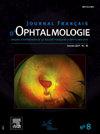无糖尿病视网膜病变的糖尿病患者的ERG、VEP和GCL厚度
IF 1.2
4区 医学
Q3 OPHTHALMOLOGY
引用次数: 0
摘要
本研究的主要目的是通过功能测试和解剖学评估,比较无糖尿病视网膜病变的糖尿病患者与对照组的视网膜神经节细胞(RGC)功能。方法采用横断面前瞻性先导研究。我们比较了无糖尿病视网膜病变的糖尿病组和对照组的功能检查(ERG和VEP - PERG和PVEP)和解剖检查(黄斑和RNFL OCT)的结果。定性资料采用χ2检验,定量资料采用t检验。显著性阈值P < 0.05。结果共纳入37只眼。没有任何人口统计学变量显示出对两组中的任何一组有显著的关联或影响。糖尿病组上、下、鼻外圈GCL厚度均显著降低,P值为<;0.001. 糖尿病组P100波振幅明显降低,P值为<;60 ‘和30 ’的模式大小为0.05,糖尿病组对15 ' vep的潜伏期更长。糖尿病组PERG反应的所有成分都发生了显著变化,P值为<;0.05.结论综合多种检测方法可作为早期检测糖尿病视网膜病变过程中视网膜神经元功能受损的一种方法。目的:比较不同类型患者的细胞、神经节、组织和组织的功能,比较不同类型患者的细胞、神经节和组织的功能,比较不同类型患者的组织和组织的功能。msamthodesune - sass - sass - sass - sass - sass - sass - sass - sass - sass - sassNous avons比较了三种不同类型的变性者,如变性者、变性者、变性者、变性者、变性者和变性者。检验χ2和检验χ2分别为:1和检验χ2,分别为:1和检验χ2,分别为:1和检验χ2,分别为:1和检验χ2,分别为:1和检验χ2,分别为:1和检验χ2。Le seuil de signation,意思是“本文章由计算机程序翻译,如有差异,请以英文原文为准。
Pattern ERG, pattern VEP, and GCL thickness in diabetic patients with no diabetic retinopathy
Purpose
The main objective of this study was to compare the retinal ganglion cell (RGC) function of diabetic patients without diabetic retinopathy with the RGC function of a control group, using functional tests and anatomical assessments.
Methods
A cross-sectional prospective pilot study was conducted on two groups. We compared the results of functional tests (Pattern ERG and Pattern VEP - PERG and PVEP) and anatomical tests (macular and RNFL OCT) in a diabetic group without diabetic retinopathy to a control group. The χ2 test was used to study qualitative data, and the t test was used for quantitative data. The significance threshold was a P value less than 0.05.
Results
A total of 37 eyes were included in the study. None of the demographic variables showed any significant association or effect on any of the two groups. GCL thickness was significantly reduced in the diabetic group in the superior, inferior, and nasal outer circles, with a P value < 0.001. The amplitude of the P100 wave was significantly reduced in the diabetic group, with a P value < 0.05 for the pattern sizes of 60′ and 30′, and the diabetic group had a longer latency for the 15′ VEPs. All of the components of the PERG responses were significantly altered in the diabetic group, with a P value < 0.05.
Conclusion
Our study indicates that combining different tests may be used as an early means of detection of compromised retinal neuron function in diabetic eyes during the course of early diabetic retinopathy.
Objectif
L’objectif principal de cette étude est de comparer la fonction des cellules ganglionnaires rétiniennes (GCL) chez les patients diabétiques sans rétinopathie diabétique avec celle d’un groupe témoin, en utilisant des tests fonctionnels et des évaluations anatomiques.
Méthodes
Une étude pilote prospective transversale a été menée sur deux groupes. Nous avons comparé les résultats des tests fonctionnels (ERG pattern et PEV pattern) et des tests anatomiques (OCT maculaire et RNFL) dans un groupe de diabétiques sans rétinopathie diabétique et dans un groupe témoin. Le test du χ2 a été utilisé pour étudier les données qualitatives et le test t a été utilisé pour les données quantitatives. Le seuil de signification était un niveau de p inférieur à 0,05.
Résultats
Un total de 37 yeux a été inclus dans l’étude. Aucune des variables démographiques n’a montré d’association significative ou d’effet sur l’un des deux groupes. L’épaisseur de la couche des cellules ganglionnaires était significativement réduite dans le groupe diabétique dans les cercles externes supérieur, inférieur et nasal avec une valeur de p < 0,001. L’amplitude de l’onde P100 était significativement réduite dans le groupe diabétique avec une valeur de p < 0,05 pour la taille de motif de 60’ et 30’, et le groupe diabétique présentait une latence plus longue pour les PEV pattern de 15’. Tous les composants des réponses ERG pattern étaient significativement altérés dans le groupe diabétique avec une valeur de p < 0,05.
Conclusion
Notre étude indique que la combinaison de différents tests peut être utilisée comme moyen précoce de détection de la fonction des neurones rétiniens dans les yeux diabétiques au cours des premiers stades de la rétinopathie diabétique.
求助全文
通过发布文献求助,成功后即可免费获取论文全文。
去求助
来源期刊
CiteScore
1.10
自引率
8.30%
发文量
317
审稿时长
49 days
期刊介绍:
The Journal français d''ophtalmologie, official publication of the French Society of Ophthalmology, serves the French Speaking Community by publishing excellent research articles, communications of the French Society of Ophthalmology, in-depth reviews, position papers, letters received by the editor and a rich image bank in each issue. The scientific quality is guaranteed through unbiased peer-review, and the journal is member of the Committee of Publication Ethics (COPE). The editors strongly discourage editorial misconduct and in particular if duplicative text from published sources is identified without proper citation, the submission will not be considered for peer review and returned to the authors or immediately rejected.

 求助内容:
求助内容: 应助结果提醒方式:
应助结果提醒方式:


